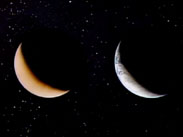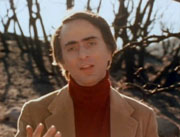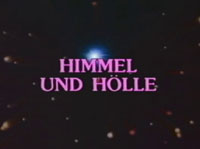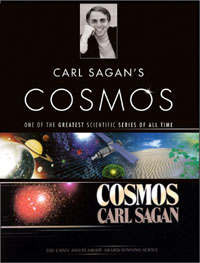|
The initial mystery of Tunguska is brought to life better in this
episode than in most other documentaries that touch on the subject,
in part because it seems that "Cosmos" managed to get hold of actual
black-and-white film footage of Soviet scientist L.A. Kulik and his team
as they traveled to, surveyed, and examined the impact site in Tunguska, Russia.
With a bit of clever editing between this, some special effects graphics,
and footage of host Carl Sagan in a similar-looking burnt-out forest,
"Cosmos" generates an unmatched illusion of having taken its audience
right to that time and place, and via its musical choices into that culture,
to witness the event.
But what happened in Tunguska? What kind of astronomical impact
causes an explosion, and fire, and flattens trees, but leaves no crater
and no meteorite fragments? Sagan recounts several proposed theories
that don't quite match the evidence. Perhaps what has gone missing
from his assumptions are concepts about how different an actual
non-terrestrial craft's construction might be, or how much of it
we should expect to find if it were shot down by a plasma
disintegration beam, originating from upset minds in underground complexes
that we're not supposed to know about. And so, he settles
on getting us to consider as most likely that the impact
was caused by a piece of a comet.
Okay, great. But while "Cosmos" here presents the definitive introduction
to this event, the answer doesn't satisfy very well until fleshed out much more fully
in the third season episode of
The Universe entitled "Deadly Comets and Meteors".
In that, we get to witness scientific computer simulations of such a proposed comet impact,
compared with and enhanced by data from the Shoemaker-Levy 9 impacts on Jupiter,
which demonstrate how a comet made mostly of ice can explode due to high-speed
friction from our atmosphere just before actually hitting the ground.
Of course, in 1980 when Cosmos was made, Jupiter had not yet been hit by
Shoemaker-Levy 9, so Sagan and company couldn't have gone that far at the time.
Still, it's nice to see a good companion documentary like the one described above
to get a fuller, more rounded payoff to the question of there being no impact crater.
Is it yet the right answer, or a well-crafted diversion from other ideas
that might be less comfortable to discuss?
"Cosmos" continues with its major examination of comets next, while continuing
its main theme that science and observation slowly but surely triumphed over superstition.
Sagan takes his share of digs at superstition here, but does not go as far as in the
previous episode, and remains tasteful about it by and large.
The best highlight of the Comet section is the very graphic "computer study"
which demonstrates a comet's orbit, and how it might change during gravitational
interaction with other planets in our solar system. One of the best parts of the episode.
Next comes a section that is more generally about collisions and impacts between
pretty much any celestial bodies that might be found in our solar system. Though
mention is made of Mercury, Mars and its moon Phobos, and Jupiter's moons Callisto and
Amalthea, with an unlabeled photo of Ganymede thrown in for good measure, it is
Earth's own Moon that receives all the big stories here. We get extensive historical
and special effects recreation of an impact that was observed and reported by
Canterbury monks in 1178 A.D., plus good coverage of the special mirrors placed by
modern moon-landing astronauts and the Earthly set-ups to bounce lasers off of those mirrors,
which apparently corroborate the large moon impact. This leads into a good section
that attempts to detail the formation and geological history of the moon so far.
Of course, the Theia impact theory had not been put forth as of 1980, so this ends
up being an interesting alternative.
"Science is a Self-Correcting Process"
One of the most precious balancing comments of the entire 1980 series comes next,
as Sagan recounts, and largely disproves, a theory of how Jupiter might have created
Venus, triggering some all-too-recent biblical "miracles" along the way. Yes, it was
pretty ridiculous, and deserved the debunking it got. But Sagan's real reprimand
is for the scientists of the day, citing their attempts to suppress the theory
as being of the same bad form as many religions in the past. New ideas should
be expressed freely and be tested by science, according to Sagan, because you never
know when that new idea might revolutionize everything. A surprising, but very,
very welcome bit, and another great highlight of this episode.
Venus - Most Like Hell
|
The next section is, for me, the main attraction of the episode.
Here, time is taken to really look at and explore Venus, once thought to be
the most attractive planet in the solar system after the Earth. It has
nearly the same size and gravity, and a similar orbit where it would be warm.
But the major thrust of the presentation here in this episode proposes
that its attractiveness was based largely on an absence of useful data,
while eager Human imagination was too quick to fill in the gaps.
|
|

|
Introduced here in the series is the concept of spectrographic analysis,
which gave us our first clue that Venus may not have such an idyllic composition
as we had at first hoped. Radioastronomy is also shown to have given us our next
batch of good data, but the truly definitive highlight is the coverage "Cosmos" gives
to the Soviet Venera Landers, including their place in history as the first man-made
objects to touch down on another planet. We see some of their early photos taken on the
surface, and get some suitable model recreations with heat-shimmer. As Sagan follows
their trajectory in his Ship of the Imagination, the dense yellow stormy clouds of
Venus make a very strong special-effects impression.
Again, this is a very compelling and indulgent recreation of an alien setting.
We come away feeling like we've been there, and that we understand fundamentally
why it's so different and strange.
But in the long term, what has stuck with me most is exactly how much
our knowledge of such a place like Venus is limited by having all of the information
filtered primarily through NASA, or to a lesser extent through the minimal publicity from
the Russian government and its space program. If they decided to squash our curiosity
to investigate Venus any further, what better way than to describe hellish temperatures
and noxious atmospheric chemistry? Might Venus be a classic example among many other planets,
moons, and places in space that are described to us as completely inhospitable or impossible
to reach, to stop us from wanting to seriously consider our options for going there?
More varied sources of unfiltered information could be a very revealing thing.
"A Little Greenhouse Effect is a Good Thing."
After only about 10 minutes of real focus on Venus, "Cosmos" allows
a comparison with Earth and our ideal environment to take over the episode.
Sagan's visit to the Sphinx in Egypt becomes his backdrop to the concept
of erosion, which can be greatly accelerated by pollution. The ultimate
take-away from this bit may be the insistence that change is the only real
constant in the universe, and that it persists throughout the cosmos.
Nowhere is static and unchanging.
Visually, a lot of the ugliness of our civilization gets screen time
in the final section here, a trigger for us to question why we don't do a
better job of cleaning up our act. A fair question.
Curiously, there is a balance here which nearly flies under the radar
and goes unnoticed. The abundant portions dealing with runaway greenhouse
effects causing global warming, as described as having been taken to the extreme on Venus,
may easily be the primary lasting impressions of the episode. But we should
also note that, perhaps expressed less eloquently, Mars is also mentioned
in contrast to our Earthly ideal environment, with the warning that
Human activity such as de-forestation brings the danger of leaving "light"
coloured bare patches on Earth, reflecting more sunlight into space instead
of absorbing it, which cools us down.... "Might this also make an ice age here?"
Sagan asks. Perhaps it is better not to walk around simply repeating mantras like
"global warming" or even "climate change" with blind passion,
but rather as this episode prompts,
to be truly AWARE of all that is going on on our planet and society -
environmentally, economically, and politically.
That partly sets us up for our response to episode 13, but to be fair,
the political and economic aspects of this are really beyond the scope
of "Cosmos". Episode 4 has kept itself interesting by focusing
predominantly on science and astronomical phenomena.
The only real key it can comment on here is the need for BALANCE,
which requires us to keenly observe how and in which directions we may have gone
or may be going out of balance in the first place.
And so, a decent episode of "Cosmos" comes to an end. While there are a lot
of good highlights that I enjoy, there are a number of other bits that are either
just average, or are not presented with enough careful depth to reveal those aspects
of the issues that really would trigger people to make the kind of changes
required to finally transcend and conquer those issues. It chips away at beginning
the process of awareness, while remaining frustratingly behind-the-times in
terms of identifying some of the real roots of the problems.
"Cosmos" has other, cleaner, more interesting episodes, although
this one is certainly not bad at all.
|











